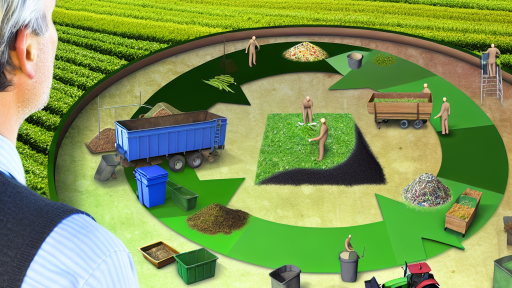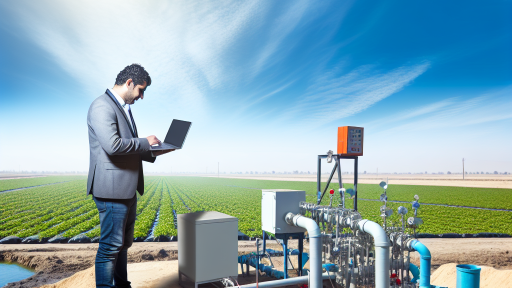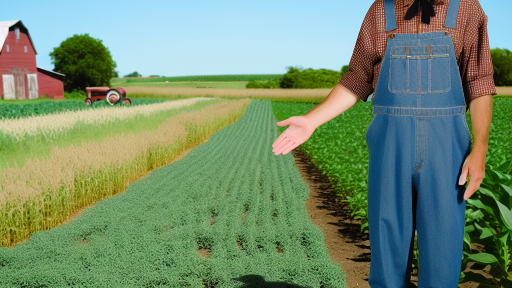Introduction to Soil Regeneration
Importance of Soil Regeneration
Soil regeneration plays a critical role in modern agriculture.
It enhances soil health and productivity.
Moreover, healthy soil sustains plant growth effectively.
Additionally, regenerated soil can retain moisture better.
Benefits for Modern Farms
Farmers gain numerous advantages from soil regeneration techniques.
First, these techniques improve crop yields significantly.
Healthy soil fosters a diverse microbial community.
This community supports essential nutrient cycling.
Second, regenerative practices reduce reliance on chemical inputs.
They promote natural pest and disease resistance.
As a result, farmers enjoy cost savings over time.
Third, soil regeneration contributes to climate resilience.
It enhances carbon sequestration capabilities.
This helps mitigate the impacts of climate change.
Ultimately, investing in soil health leads to sustainable farming.
Transform Your Agribusiness
Unlock your farm's potential with expert advice tailored to your needs. Get actionable steps that drive real results.
Get StartedFarmers can ensure food security for future generations.
Key Principles of Soil Health
Understanding Soil Composition
Soi consists of minerals, organic matter, air, and water.
The balance between these components affects soil fertility.
Minerals provide essential nutrients for plant growth.
Organic matter improves soil structure and moisture retention.
Air and water play critical roles in supporting microbial life.
The Role of Microorganisms
Microorganisms are vital for soil health and nutrient cycling.
Bacteria and fungi decompose organic materials, releasing nutrients.
They also help break down complex compounds in the soil.
This process enriches the soil and enhances its productivity.
Soil pH and Plant Growth
Soil pH influences nutrient availability for plants.
Most crops thrive in a pH range of 6.0 to 7.5.
Acidic or alkaline soils may lead to nutrient deficiencies.
Regular soil testing can help maintain optimal pH levels.
Importance of Soil Structure
Soil structure affects water drainage and root penetration.
Well-structured soil promotes healthy plant growth.
Compacted soil can restrict root development and air exchange.
Practices like no-till farming can improve soil structure.
Water Management
Effective water management preserves soil health.
Excessive water can lead to erosion and nutrient runoff.
Implementing drip irrigation conserves water while supporting crops.
Rainwater harvesting can also enhance water availability.
Cover Cropping: Selecting the Right Crops for Soil Improvement
Importance of Cover Cropping
Cover cropping plays a crucial role in soil health.
It helps prevent erosion and retain moisture.
Showcase Your Farming Business
Publish your professional farming services profile on our blog for a one-time fee of $200 and reach a dedicated audience of farmers and agribusiness owners.
Publish Your ProfileAdditionally, cover crops can suppress weeds effectively.
They also enhance nutrient cycling within the soil.
Criteria for Selecting Cover Crops
Choosing the right cover crop requires careful consideration.
First, assess the local climate and soil type.
Next, consider the primary goals of your cover cropping strategy.
For instance, do you aim to improve soil structure or increase fertility?
Common Types of Cover Crops
Various types of cover crops are available for farmers.
- Legumes, such as clover or vetch, fix nitrogen in the soil.
- Cereal grains like rye or oats help improve soil structure.
- Brassicas, including radishes, can aid in breaking up compact soil.
Timing and Management
Timing is essential for optimal cover crop benefits.
Sow cover crops after the main crop harvest.
Manage growth by mowing or rolling before planting the next cash crop.
This practice maximizes soil coverage and nutrient retention.
Potential Challenges
While beneficial, cover cropping may present challenges.
Farmers might face issues with termination timing and methods.
Additionally, some cover crops could harbor pests if not managed properly.
Thus, continuous monitoring is vital for success.
You Might Also Like: Organic Farming Infrastructure Tips For Sustainable Growth
Crop Rotation Techniques
Enhancing Nutrient Cycling
Crop rotation improves soil health by enhancing nutrient cycling.
Diverse crops contribute to various nutrient needs in the soil.
This practice reduces the dependency on chemical fertilizers.
For example, legumes add nitrogen back into the soil.
Rotating crops naturally promotes richer soil over time.
Farmers can plan rotations based on the nutrient profiles of crops.
Such a method ensures continuous improvement in soil fertility.
Pest Control Benefits
Certain crops deter specific pests effectively.
Crop rotation disrupts the life cycles of harmful insects.
This reduces the need for pesticides, promoting a healthier farm.
Additionally, the varied root systems enhance soil structure.
Healthier soil naturally supports beneficial organisms.
Consequently, this leads to a balanced ecosystem on the farm.
Implementing a Crop Rotation Plan
Begin by assessing the current crops being grown.
Next, analyze the nutrient requirements of future crops.
Create a rotation schedule that caters to soil needs and pest management.
Monitor the results and make adjustments as necessary.
Engaging with local agricultural extensions can provide useful insights.
Farmers should share their experiences to improve collective practices.
Ultimately, effective crop rotation enhances both yield and soil health.
Gain More Insights: Enhancing Soil Health through Integrated Pest Management
No-Till and Reduced Tillage Practices
Minimizing Soil Disturbance
No-till and reduced tillage practices revolutionize modern farming.
These techniques maintain soil structure and enhance biodiversity.
Farmers who adopt these practices often see improved yields.
Showcase Your Farming Business
Publish your professional farming services profile on our blog for a one-time fee of $200 and reach a dedicated audience of farmers and agribusiness owners.
Publish Your ProfileAdditionally, these methods significantly reduce soil erosion.
Restoring the soil’s health becomes simpler with minimal disturbance.
Benefits of No-Till Farming
No-till farming offers numerous advantages for sustainable agriculture.
One major benefit is the conservation of soil moisture.
This technique also helps in carbon sequestration.
Importantly, it reduces fuel and labor costs for farmers.
Healthy soils produce more resilient crops over time.
Implementing Reduced Tillage Practices
Reduced tillage can be an effective step toward sustainability.
This method involves limited soil disturbance compared to traditional tilling.
Farmers can benefit from cover crops to enhance soil health.
Cover crops prevent erosion and provide organic matter.
Furthermore, reduced tillage encourages beneficial soil organisms.
Challenges and Considerations
Transitioning to no-till or reduced tillage requires careful planning.
Farmers must address potential weed management issues.
They may also need to adjust their crop rotation strategies.
Moreover, soil compaction can be a concern if not managed properly.
Education and support networks play a crucial role in this process.
Real-World Examples
Numerous farms successfully implement these practices worldwide.
The Thompson Family Farm in Oregon showcases effective no-till methods.
They have seen remarkable improvements in soil quality and crop yields.
Additionally, Greenfield Farms in Canada adopts reduced tillage techniques.
They focus on building healthy soil to foster sustainable growth.
Delve into the Subject: IPM Best Practices for Sustainable Agriculture
Composting and Organic Amendments: Enhancing Soil Fertility Naturally
Introduction to Composting
Composting transforms organic waste into valuable soil amendments.
This process reduces landfill waste while enriching soil health.
Farmers benefit from free organic fertilizer that enhances fertility.
Basic Principles of Composting
Successful composting requires a balance of carbon and nitrogen.
Carbon-rich materials include leaves and straw.
Nitrogen-rich materials consist of kitchen scraps and grass clippings.
Aeration is key for breaking down materials efficiently.
Regularly turning the pile enhances airflow and speeds decomposition.
Types of Organic Amendments
Organic amendments improve soil structure, fertility, and microbial activity.
Common organic amendments include compost, manure, and cover crops.
Benefits of Compost
Compost boosts nutrient retention and availability for plants.
It improves soil texture and promotes better drainage.
Microbial populations thrive, enhancing disease resistance in crops.
Using Manure as an Amendment
Well-composted manure serves as a potent organic fertilizer.
It contains essential nutrients like nitrogen, phosphorous, and potassium.
Properly managing manure prevents harmful pathogens in soils.
Cover Crops: A Regenerative Practice
Cover crops protect soil from erosion while improving fertility.
Showcase Your Farming Business
Publish your professional farming services profile on our blog for a one-time fee of $200 and reach a dedicated audience of farmers and agribusiness owners.
Publish Your ProfileThey contribute organic matter and nutrients when tilled into the soil.
Crops like clover and rye enrich the soil and suppress weeds.
How to Implement Cover Crops
Choose cover crops suited to your region and cropping system.
Sow cover crops after the harvest for optimal growth.
Terminate the cover crop before planting the next cash crop.
Biodiversity and Microbial Activity
Enhancing biodiversity through organic practices boosts soil health.
Diverse microbial populations lead to more resilient agricultural systems.
Applying compost and organic amendments supports these beneficial organisms.
Monitoring Soil Health
Regular soil testing helps farmers track nutrient levels and pH.
Adjust amendment applications based on test results to optimize health.
Soil health indicators include earthworm presence and organic matter levels.
You Might Also Like: Composting Basics For Better Soil Health

Use of Biochar: Improving Soil Structure and Water Retention
Introduction to Biochar
Biochar is a carbon-rich material created through pyrolysis.
This process involves heating organic matter in the absence of oxygen.
Farmers widely recognize biochar for its ability to enhance soil health.
Benefits of Biochar for Soil Structure
One significant advantage of biochar is its ability to improve soil structure.
It increases porosity, allowing for better air circulation.
Furthermore, biochar promotes root penetration and development.
As a result, plant growth becomes more vigorous and resilient.
Enhancing Water Retention
Biochar also plays a critical role in water retention.
It can absorb and hold large amounts of water due to its porous nature.
This capacity reduces the need for frequent irrigation.
In arid regions, efficient water use is particularly beneficial.
Application Techniques
Applying biochar effectively requires specific techniques.
First, incorporate biochar into the soil before planting.
This integration ensures that the benefits become readily available.
Additionally, consider mixing it with compost for more nutrients.
Environmental Impact
Using biochar can positively impact the environment significantly.
It sequesters carbon, thus reducing greenhouse gas emissions.
Moreover, biochar can improve soil fertility over time.
This enhancement leads to healthier crops and a sustainable farm ecosystem.
Real-World Examples
Farmers worldwide are adopting biochar practices successfully.
For example, Clara’s Organic Farm in Vermont reports increased yields.
The farm also experiences reduced watering needs since applying biochar.
Implications of Using Biochar
The use of biochar shows great promise for modern agriculture.
It not only improves soil structure but also enhances water retention.
Farmers who adopt biochar can achieve sustainable farming goals.
Integrating Livestock: The Role of Grazing in Soil Regeneration
Understanding the Benefits of Grazing
Grazing plays a vital role in soil regeneration.
It contributes to the health of grasses and other plants.
Healthy plants improve soil structure and fertility.
Showcase Your Farming Business
Publish your professional farming services profile on our blog for a one-time fee of $200 and reach a dedicated audience of farmers and agribusiness owners.
Publish Your ProfileIn addition, grazing helps in nutrient cycling.
Livestock manure enriches the soil with organic matter.
This organic matter enhances moisture retention.
Consequently, crops become more resilient to drought.
Types of Grazing Techniques
Farmers can implement various grazing strategies.
Rotational grazing promotes better land usage.
This technique involves moving livestock between pastures.
As a result, it allows for rest and regrowth of vegetation.
Furthermore, mob grazing encourages dense forage consumption.
This increases soil disturbance and aeration.
Consequently, it promotes a healthier root system.
Challenges of Integrating Livestock
Several challenges can arise when integrating livestock.
Overgrazing can lead to soil compaction.
It reduces the soil’s ability to absorb water.
In addition, overgrazing may deplete native plant species.
Farmers must monitor grass height and growth.
Effective management practices can mitigate these issues.
Therefore, careful planning is essential for success.
Benefits of Livestock Integration
Integrating livestock through grazing techniques yields significant benefits.
Proper management enhances soil regeneration efforts.
Ultimately, it supports sustainable farming practices.
Monitoring and Assessing Soil Health
Importance of Soil Health
Soyl health is crucial for productive agriculture.
Healthy soils enhance crop yields and resilience.
They also contribute to sustainable farming practices.
Tools for Soil Monitoring
Farmers use various tools to monitor soil health.
Soil test kits are popular for assessing nutrient levels.
These kits provide information on pH, nitrogen, and phosphorus.
Additionally, moisture sensors help manage irrigation effectively.
Visual Assessment Techniques
Visual assessments can quickly indicate soil condition.
Farmers often look for signs of erosion and compaction.
Color changes in soil may indicate nutrient deficiencies.
Therefore, regular visual inspections are beneficial.
Using Technology for Soil Analysis
Technological advancements improve soil assessment accuracy.
Drones equipped with sensors collect soil data efficiently.
Additionally, satellite imagery helps track changes over time.
Farm management software consolidates soil data for analysis.
Collaboration with Soil Experts
Working with soil scientists offers deeper insights.
They can recommend specific amendments and practices.
Consultations often lead to better soil management strategies.
Continuous Monitoring Practices
Implementing continuous soil monitoring is beneficial.
Showcase Your Farming Business
Publish your professional farming services profile on our blog for a one-time fee of $200 and reach a dedicated audience of farmers and agribusiness owners.
Publish Your ProfileRegular testing allows farmers to adjust management practices.
This proactive approach fosters long-term soil health.
Additional Resources
The Indigenous Origins of Regenerative Agriculture – National …




